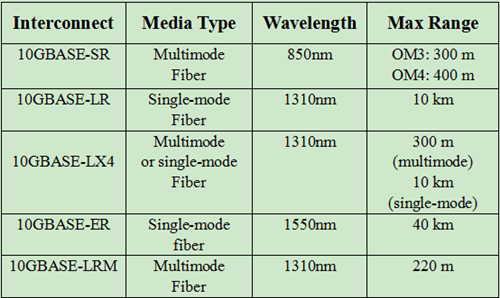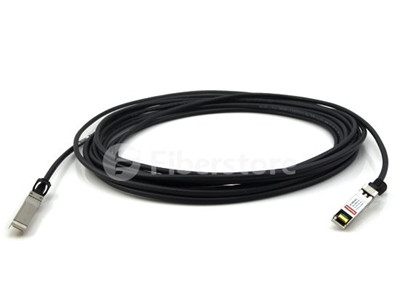The accelerating growth of worldwide network traffic is forcing service providers, enterprise network managers and architects to look to ever higher-speed network technologies, just as the cabling technologies that support them are changing continually. Both IEEE802.3 standards and the associated 10G cabling technologies have assumed many forms in order to determine what 10G cabling strategy best suits a particular organization. The 10GbE standards outlined below help define and optimize the environment in which they operate and the cabling technologies over which they communicate. After going through this passage, you may find a suitable cabling for your 10G network.
IEEE802.3ae
Ratified in June 2002, the IEEE802.3ae LAN standard was developed to update the preexisting IEEE802.3 standard for 10GbE fiber transmission. With the new standard, seven new media types were defined for LAN, metropolitan area network (MAN) and wide area network (WAN) connectivity:
Ratified in June 2002, the IEEE802.3ae LAN standard was developed to update the preexisting IEEE802.3 standard for 10GbE fiber transmission. With the new standard, seven new media types were defined for LAN, metropolitan area network (MAN) and wide area network (WAN) connectivity:
- 10GBASE-SR—uses the lowest cost optics (850nm) to support 10GbE transmission over standard multimode fiber for distances of 33 and 86 meters. The SR standard also supports up to 300 meters using the new 2000MHz/km multimode fiber (laser-optimized). SR is the lowest-cost optics of all defined 10GbE optics. Take JD092B as an example, it can support a link length of 300m over OM3.
- 10GBASE-LR—uses higher cost optics (1310nm) than SR and requires more complex alignment of the optics to support single-mode fiber up to 10 km.
- 10GBASE-LX4—supports traditional FDDI grade multimode fiber for distances up to 300 meters using Coarse Wavelength Division Multiplexing (CWDM) at 3.125 Gbit/s. The LX4 standard also supports single-mode fiber for up to 10 Km. LX4 is more expensive than both SR and LR because it requires four times the optical and electrical circuitry in addition to optical multiplexers.
- 10GBASE-ER—uses the most expensive optics (1550nm) to support single-mode fiber up to 30 km. For 40km, the fiber-optic connection must be an engineered link.
- 10GBASE-LRM—ratified by IEEE, uses a technology called EDC (Electronic Dispersion Compensation). 10GBASE-LRM can provide a long distance solution based on multimode fiber and operates with a single wavelength of 1310nm.
- 10GBASE-SW, 10GBASE-LW, 10GBASE-EW—defined for use with a WAN PHY. These standards were defined to operate at the same baud rate as OC-192/STM-64 SONET/SDH equipment. They are the equivalent of the SR, LR and ER standards and support the same fiber cabling. LX4 does not have an equivalent WAN PHY standard.

IEEE802.3ak
10GBASE-CX4 was the first 10G copper standard certificated by 802.3ak in 2004. As the first 10GbE copper cabling standard, 10GBASE-CX4 provides immediate advantages with its affordability and wide availability, which is a low-cost 10GbE solution intended for copper cabling within short distance connectivity for wiring closet and data center connectivity. Another aspect of the 10GBASE-CX4 is that it has a bigger form factor and more bulky cables than the newer single lane SFP+ standard and has a much shorter reach than fiber or 10GBASE-T as well. CX4 cables must be factory terminated to meet defined specifications so they should be ordered to length. Like 10GBASE-CX4, SFP+ Direct Attach Cable is low-power, low-cost and low-latency with the added advantages of using less bulky cables and of having the small form factor of SFP+. For example, JD097C (see in the below image) is the compatible HP SFP+ passive copper cable, which is widely used in 10G data center.
10GBASE-CX4 was the first 10G copper standard certificated by 802.3ak in 2004. As the first 10GbE copper cabling standard, 10GBASE-CX4 provides immediate advantages with its affordability and wide availability, which is a low-cost 10GbE solution intended for copper cabling within short distance connectivity for wiring closet and data center connectivity. Another aspect of the 10GBASE-CX4 is that it has a bigger form factor and more bulky cables than the newer single lane SFP+ standard and has a much shorter reach than fiber or 10GBASE-T as well. CX4 cables must be factory terminated to meet defined specifications so they should be ordered to length. Like 10GBASE-CX4, SFP+ Direct Attach Cable is low-power, low-cost and low-latency with the added advantages of using less bulky cables and of having the small form factor of SFP+. For example, JD097C (see in the below image) is the compatible HP SFP+ passive copper cable, which is widely used in 10G data center.

IEEE802.3an
Proposed in November 2002, 10GBASE-T is the 10GbE standard for use with unshielded twisted-pair (UTP) style cabling. The goal of this copper standard, which is expected to be ratified in the year 2006, is to approximate RJ-45 connectivity of 100 meters. It is intended to improve the performance and distance of copper cabling at a cost that is lower or similar to fiber. Category 5 (Cat 5) and Category 6 (Cat 6) are the most common cabling systems being installed today, but Cat 5 is not capable of meeting the bandwidth and crosstalk demands of 10GbE’s higher transmission speeds. The expected cabling standard is Category 6A (Cat 6A), designed with existing Cat 6 cable but measured and specified to higher frequencies. In addition to Cat 6A, 10GBASE-T will operate on Category 7 (Cat 7) cables.
Proposed in November 2002, 10GBASE-T is the 10GbE standard for use with unshielded twisted-pair (UTP) style cabling. The goal of this copper standard, which is expected to be ratified in the year 2006, is to approximate RJ-45 connectivity of 100 meters. It is intended to improve the performance and distance of copper cabling at a cost that is lower or similar to fiber. Category 5 (Cat 5) and Category 6 (Cat 6) are the most common cabling systems being installed today, but Cat 5 is not capable of meeting the bandwidth and crosstalk demands of 10GbE’s higher transmission speeds. The expected cabling standard is Category 6A (Cat 6A), designed with existing Cat 6 cable but measured and specified to higher frequencies. In addition to Cat 6A, 10GBASE-T will operate on Category 7 (Cat 7) cables.
Conclusion
Lately, Gigabit Ethernet has been deployed as a backbone technology for telecommunication industry. For 10GbE, the IEEE standard has been evolved from IEEE802.3ae to IEEE802.3an (10GBASE-T) for offering better 10G performance to adapt to the market demand. With so many fiber or cooper cabling technologies available for 10GbE, we must have a solid understanding of the environment and need to develop a sound cabling strategy for your infrastructure. Fiberstore offers a full range of 10 Gigabit Ethernet interfaces, SFP+ transceivers and cables. You can find what you want here.
Lately, Gigabit Ethernet has been deployed as a backbone technology for telecommunication industry. For 10GbE, the IEEE standard has been evolved from IEEE802.3ae to IEEE802.3an (10GBASE-T) for offering better 10G performance to adapt to the market demand. With so many fiber or cooper cabling technologies available for 10GbE, we must have a solid understanding of the environment and need to develop a sound cabling strategy for your infrastructure. Fiberstore offers a full range of 10 Gigabit Ethernet interfaces, SFP+ transceivers and cables. You can find what you want here.
评论
发表评论